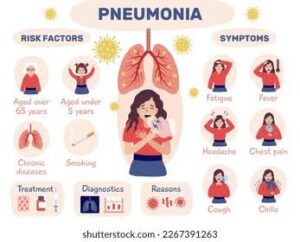Back to: MICROBIOLOGY 300 LEVEL
Welcome to class!
It’s always a pleasure to have you here. Today, we’re talking about three major respiratory diseases that continue to affect millions of people, especially across Africa: Pneumonia, Tuberculosis, and Whooping Cough. These illnesses aren’t just part of textbook theory—they’re part of real-life experiences in our homes, communities, and healthcare systems. As a microbiology student, understanding these diseases equips you to tackle them with knowledge, empathy, and scientific skill.
Pneumonia, Tuberculosis, Whooping Cough
Pneumonia

Pneumonia is an infection that inflames the air sacs (alveoli) in the lungs. These air sacs may fill with fluid or pus, making it difficult to breathe.
Common Cause:
Streptococcus pneumoniae is one of the leading causes, but viruses and fungi can also cause it.
Symptoms:
Cough, fever, chills, difficulty breathing, chest pain, and fatigue. In children, fast breathing and chest in-drawing may be signs.
At-risk groups:
Children under five, elderly people, and those with chronic conditions like asthma or HIV/AIDS.
Transmission:
Spread through inhalation of droplets from an infected person’s cough or sneeze.
Treatment:
Depends on the cause—bacterial pneumonia requires antibiotics. Supportive care like fluids and rest is also important.

Prevention:
Vaccination (e.g. PCV), good nutrition, and hygiene practices.
Imagine a grandmother in Ibadan developing a persistent cough and fever during the Harmattan season. She is later diagnosed with bacterial pneumonia and treated early—saving her from life-threatening complications.
Tuberculosis (TB)
TB is a chronic infectious disease mainly affecting the lungs, caused by Mycobacterium tuberculosis.
Symptoms:
Persistent cough lasting more than two weeks, weight loss, night sweats, fever, and coughing up blood.
Transmission:
Airborne spread—especially in crowded places or poorly ventilated environments.
Diagnosis:
Sputum microscopy, chest X-ray, and GeneXpert tests.
Treatment:
A six-month course of multiple antibiotics. Missing doses can lead to drug-resistant TB.
Public health relevance:
Nigeria is one of the high-burden countries for TB. Early detection and adherence to treatment are crucial.
Think of a young bus conductor in Lagos who has had a persistent cough and night sweats. After visiting a clinic, he’s diagnosed with TB. Free treatment is provided through the national TB programme, helping him recover and stop the spread.
Whooping Cough (Pertussis)
This is a highly contagious bacterial disease caused by Bordetella pertussis.

Symptoms:
Begins like a cold, followed by severe coughing fits with a “whoop” sound. Vomiting after coughing and difficulty breathing are common, especially in infants.
Who is most at risk:
Infants under 6 months are at highest risk of complications and death.
Transmission:
Spread through droplets when an infected person coughs or sneezes.
Prevention:
DTP vaccination—given in infancy and part of Nigeria’s routine immunisation schedule.
Treatment:
Antibiotics like azithromycin and supportive care, especially oxygen for infants struggling to breathe.
Picture a baby in Enugu who hasn’t received routine vaccines. After weeks of coughing, she develops severe breathing difficulties. She’s rushed to the clinic, where pertussis is confirmed. With early care, she survives—but the situation could have been avoided with timely vaccination.
Summary
- Pneumonia causes fluid-filled lungs and is a leading cause of child death.
- Tuberculosis is a slow-progressing but deadly airborne infection requiring long-term treatment.
- Whooping cough causes intense coughing fits and is particularly dangerous for babies.
- Prevention through vaccines, early diagnosis, and prompt treatment saves lives.
Evaluation
- What organism most commonly causes pneumonia in children?
- How is tuberculosis different from pneumonia in terms of duration and treatment?
- Why is whooping cough more dangerous in infants?
These diseases may seem tough, but with the knowledge you’re gaining, you’re becoming someone who can change lives. Keep going—Afrilearn is with you all the way, cheering you on as you grow into a confident and compassionate healthcare professional. See you next class!
